Reigning Horses
Like most photographers, I am often asked about my most memorable assignments. My revolving answers usually have three basic components: a major event that resulted in a memorable image, a good story about getting an image, or the weather was simply spectacular.
Weather is such an important part of my job, from the practical elements of the light and the gear I'll need, to the added stress of producing images under less than ideal conditions.
The 2015 Preakness was such a day.
I rarely shoot horse racing. I’ve shot the final turn at the Preakness and Belmont on occasion, but that is the entirety of my involvement in the sport.
The races are certainly a spectacle, and given nice weather, not a bad way to spend a Saturday.
My 2015 Preakness really started at the 2014 Belmont. Someone recommended Dan Neri, a new hire at Canon USA, to assist me. As Dan and I rolled our gear into Belmont Park near our fourth turn location, we crossed paths with a concert stage. Someone approached us and asked, ”Are you with the band?” That was the beginning of a stunning, sun-splashed day when Triple Crown hopeful California Chrome finished fourth, rendering our 12 hours of work pointless.
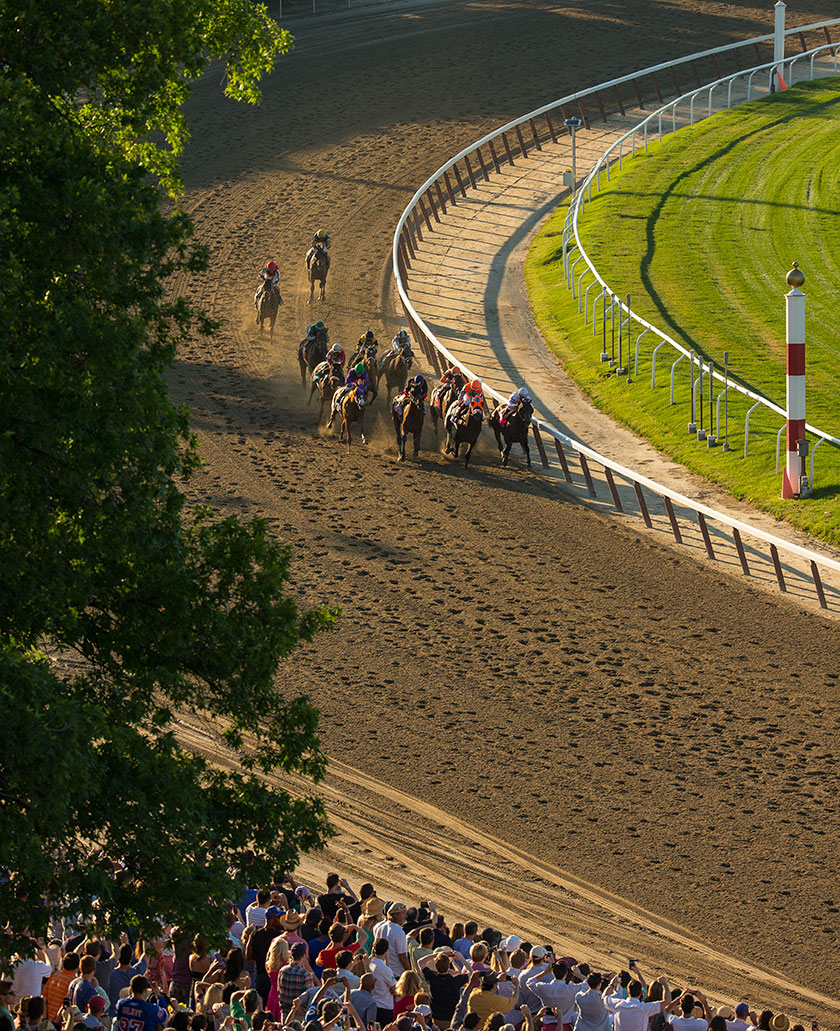
The 2014 Belmont was run on a spectacular spring day
When assigned this year's Preakness I immediately texted Dan, “We’re getting the band back together.” Dan’s job at Canon is to integrate the business of selling cameras with the reality of professional photographers’ jobs. Being able to spend a day with Dan, and learn what they think we need the cameras to do, and show him what we really need them to do, and how we use them, is mutually enlightening.
The one potential hiccup in our plans was a small notation on my Weather.com app. Since early in the week the Saturday forcast called for afternoon rain. With the race scheduled to start at 6:19pm, it simply meant that we had to be ready, just in case. Setup and testing during the day's races would be unaffected, but we may be dealing with changing light and rain gear for the race.
Preakness morning started at 7:00am when we carted our gear into the VIP tunnel at the end of the home stretch and set up camp. My editor at SI and I decided to forgo the infield remotes that would sit under the inside rail. As the lone photographer (SI usually sent at least two) I needed more access to my two assistants (my son Aaron was the second) especially given the possibility of “weather” at race time. We were essentially babysitting a race editors did not think American Pharoah, the Kentucky Derby winner, would win. As the middle of the Triple Crown races, the Preakness was only newsworthy to SI if American Pharoah won….this was all about the lead up to the Belmont and a possible Triple Crown winner.
We started by simply setting up a series of long lenses pointed at the finish line. We roughed in the focus and the framing, in anticipation of the 2nd, 5th, 7th and 10th races; the only races prior to the Preakness (13th race) run on the dirt track (the others ran on the inner Turf track). I’d like to tell you there is some science to setting up remotes, but it’s simply a matter of covering the real estate and taking some educated guesses.

Roughing in the lenses for the finish line
Will the horses be bunched together at the finish? Will the lead horse be on the rail, in the middle, on the outside? Will the horse be holding a lead or making a late run? Will the winning jockey celebrate early, or late? These are all simply unknowable facts, and since the best stories are often those that break from the norm, trying to use logic almost always backfires. This was a much smaller set of cameras than SI usually has at a finish line. This was about your gut feeling…what do you think is going to happen, and more importantly, what’s the picture you want to make?
Dan and I combined our resources and came up with a package of Canon EF lenses mounted on Canon 1DX bodies. Shooting Raw-only to get some buffer leverage, we covered the finish line, and created some focus options for that crucial reaction.
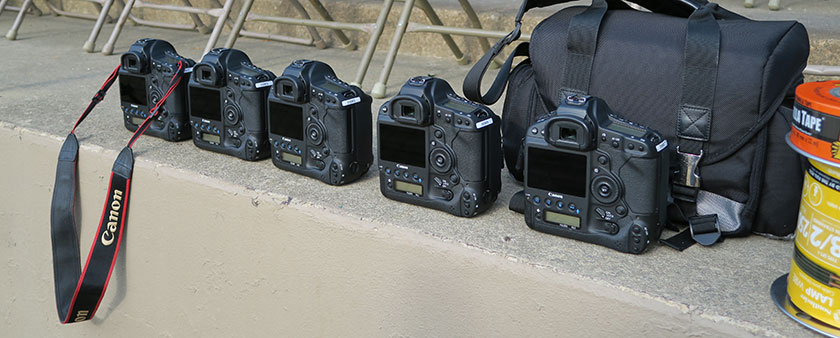
Once our remotes were set up we did a quick location scout and I talked my way onto a fire escape to shoot the race elevated. I then found the fastest path back to the track crossing so I could make my way to the trophy presentation after the race.
The plan was pretty simple. Dan and Aaron had the remote lenses split up, and would fire them with triggers and foot switches at predetermined points. What was happening in the race was irrelevant, because they would fire the cameras when the horses passed through the predetermined plane of focus. Each of the four prior races resulted in minor tweaks to our positioning and focus on all the lenses, but we felt good about our set of images covering the finish line.
On Saturday the chance of rain fluctuated all day. Around 2pm, the forecast was for 60% chance of rain at 6pm, 80% at 7pm. We pulled out the tarps and covered the empty cases and camera bags and started fielding weather questions from curious fans. An hour later the percentages had dropped to 40% and 50%, but the 8pm percentage started to grow. By 5pm, the forecast was 35%, 25%, and 100% at 8pm. Unfortunately rain does not fall from the weather.com app, but the black clouds that formed overhead. They passed over, but the intermittent drops we felt brought out our rain covers and Glad trash bags, which we knotted to the tripods. We started to make serious plans for rain during the race. The 1DX cameras can withstand a lot of rain, the lenses to a lesser extent, and the front elements of the lenses, well, I didn’t come here to shoot diffused horses. We discussed covering and uncovering the gear and agreed on the covered VIP entrance as the place where we would re-stage the gear for repacking. I could then swap out lenses on the way to the trophy presentation.
I commented that I hoped that if it rained during the race, we got really hammered so at least the hassle would be worth some good pictures. If there is a being that controls the weather, this surely sealed our fate.
After the 10th and final race on the dirt, we made our final adjustments to the remotes, and I made my way up to the stairway that the guards assured me would be empty. It was not, and a dentist and his investor friends enlisted me for some group shots. I could not help notice the lightning to the east where the earlier dark clouds vented their anger. More alarming however was the band of darkness to the west. It was 5:50, 29 minutes until the race, and a line of black clouds headed our way at a healthy pace. The distant lightning became more frequent as the horses were led onto the turf track, and at 6:10 rain started to fall.

I watched from above as Dan and Aaron sealed the front elements with the garbage bags and the rain intensified. The wall of clouds and rain approaching from the west seemed perfectly timed with the race’s start time. The wind began to pick up and I huddled up against a small corner on the platform with my new friends, patrons of the grandstand restaurant.
As the horses paraded down the home stretch a final time before their walk to the starting gate, all hell broke loose. The wind began to gust, with a swirling mist that enveloped the grounds. The grandstand emptied instantaneously and a torrential downpour slid over the field. The portable, wheeled bridges that crossed fans across the dusty sand track now carried fleeing patrons back across a river of glistening mud. The horses continued their march to the starting gate in the far northwest corner of the track. They disappeared into the mist, and the group of us that remained on the platform peered into the gloom and speculated if they would actually run the race. The grandstand was empty, and we could not see beyond the bright yellow sign above the starting gate.
As Post time approached I saw through my lens the horses filling up the starting gate. I motioned to Aaron and Dan to remove the trash bags from the lenses. We planned to shoot the first pass, assuming the horses would be packed closer together along the rail. I watched them both frantically deal with the wind-whipped trash bags as they came off. I had no idea if the lenses would still be aimed straight or if the front elements would be dry by the time the field came around again for the finish. I looked down on Aaron and saw only his white Nike's, submerged in several inches of running water.
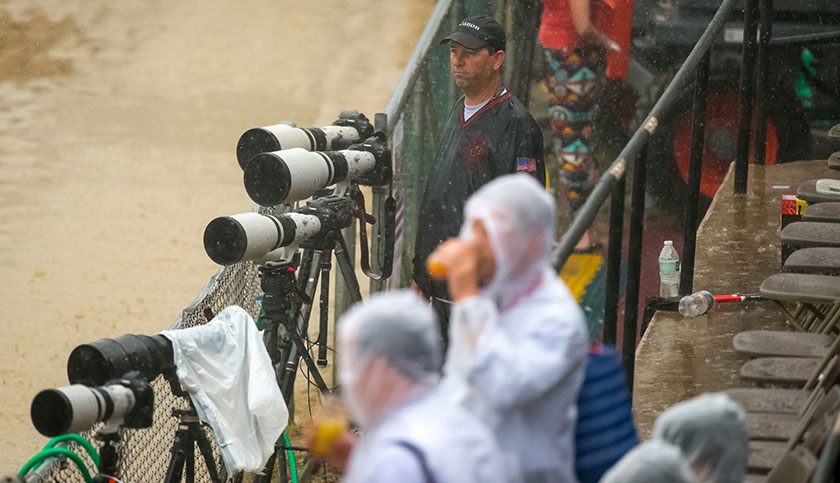
Dan Neri awaits the finish of the Preakness
When the fans realized the race was going to be run, people splashed back down the grandstand, going crazy at the edge of the track. And suddenly they were off. The 2015 Preakness would be run in a driving rain!
American Pharoah took an early lead, splashed past the finish line, and disappeared around the first bend with the other seven horses. A sympathetic film-maker brought out linen napkins from the restaurant for myself and another photographer, and we made a quick attempt to dry our gear. The rain was too dense to make out what was happening on the infield video screens and it wasn't until the horses made their final turn that we saw them again. With the horses stretched out, I deactivated the built in extender in the 200-400 and waited a little longer until I started to shoot. It was almost impossible to tell if the auto focus was working because there was little or no contrast through the rain. I saw the field start to stretch out and the leading horse was pulling away. I fought my way under the lens’ rain cover and zoomed out to try and keep at least the nearest horses in the frame, but the lead was too big. I did however finally recognize the silks and realized American Pharoah had won. This babysitting gig had turned into a news story.

Post-race in the VIP Walkway
I sprinted down the stairs and met Dan and Aaron in the VIP tunnel. They were drenched, and had all the gear under cover. I swapped my long zoom for a shorter one and the VIP gate guard Claudio opened the gate for me to head up towards he fish line. (God bless Gore Tex footwear: there is something magical about walking through puddled sand and arriving on the infield with dry feet.) I was one of the last people to make it to the trophy presentation as the finely dressed conglomerate of owners danced and hugged in the rain. The winning horse, seemingly unfazed by all the commotion, paraded in wrapped in a sash of Black Eyed Susans.
As I shot the awards presentation, my mind started to wander to the remotes. What did we get? How was our framing, or focus choice? How had the rain affected the front element or even just the look of the image? Had the lenses survived the placement and removal of the rain covers? Where had the jockey actually raised his arm in celebration? It was done, there was no redoing it. The images on those cards were all we had…five maybe 10 sharp frames of the finish.
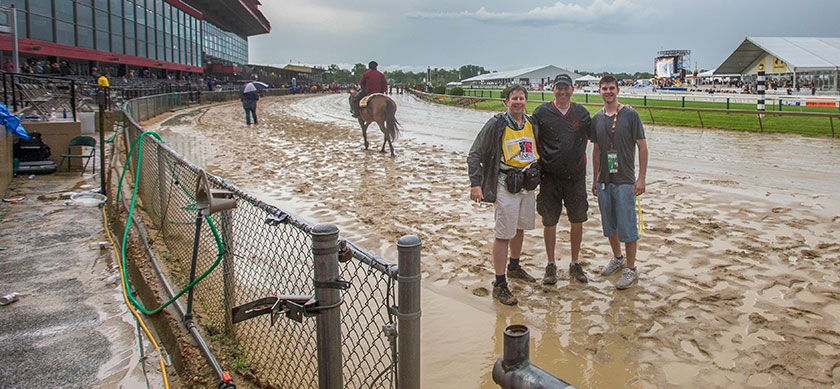
Me, Dan and Aaron ready to head home
At 7:33, one hour and 14 minutes after the race went off, we were sitting in traffic on Baltimore's Northern Parkway. By 10 pm the gear was unpacked and drying out in my family room. Cards were downloaded and transmitted to SI. The Belmont was three weeks away.
Below are a few of pictures from some of our finish line remotes with notes on their intent and the eventual results.
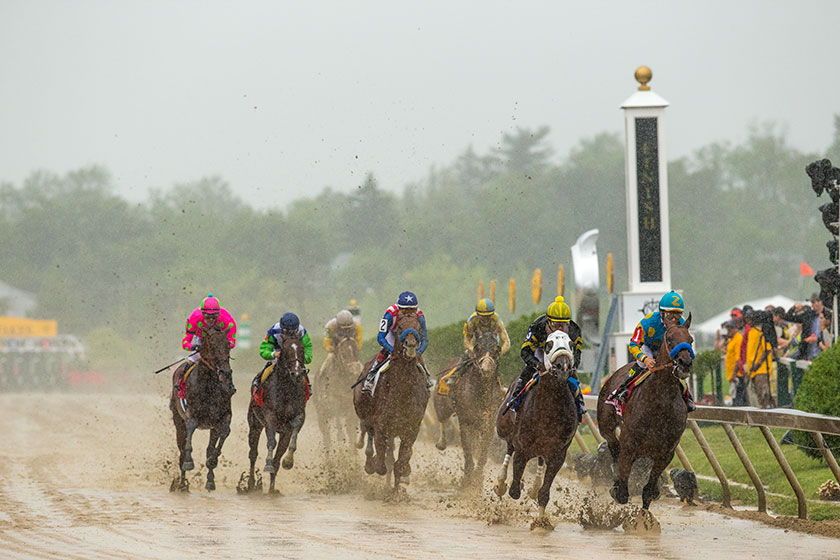
300mm: This was our safety valve in case of a tight finish to the outside or a close race with late celebration. This shot of the first pass ran in SI as the Lineup Page, but the celebration, much farther back towards the finish, was completely out of focus.
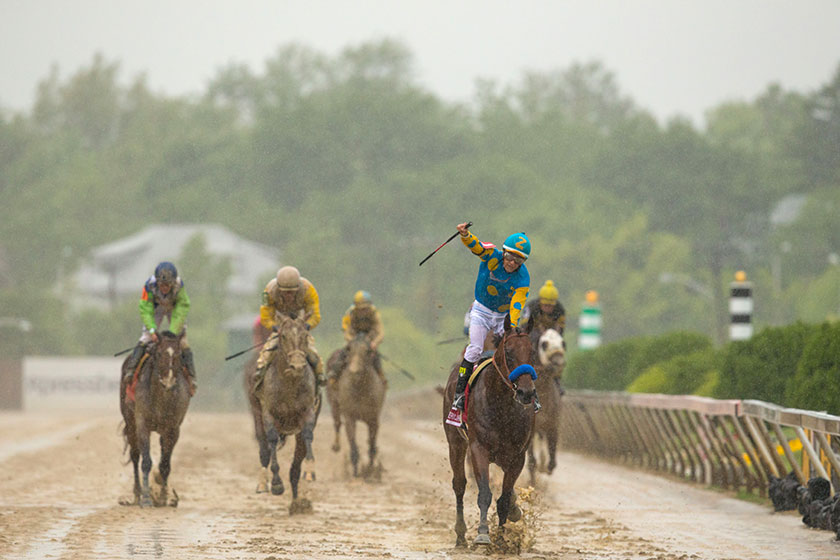
This was the full frame of the 500mm which was our most-likely-to-succeed remote. A good balance of spacing and a little luck on the focus overcame the lens settling a little high. Likely caused by the mad rush to place and remove the rain covers, the focus barely allowed the feet/splash to make it in the frame. Remotes and rain...not a good combination.
Thanks to Dan Neri for some of our production shots. All race images (c)2015 Sports Illustrated/Al Tielemans

